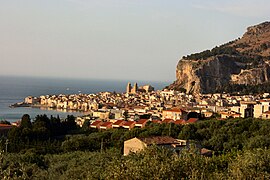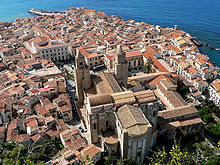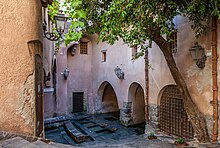Cefalù
| Cefalù | ||
|---|---|---|

|
|
|
| Country | Italy | |
| region | Sicily | |
| Metropolitan city | Palermo (PA) | |
| Local name | Cifalù | |
| Coordinates | 38 ° 2 ' N , 14 ° 1' E | |
| height | 16 m slm | |
| surface | 65 km² | |
| Residents | 14,155 (Dec. 31, 2019) | |
| Population density | 218 inhabitants / km² | |
| Factions | S. Ambrogio , Gibilmanna | |
| Post Code | 90015 | |
| prefix | 0921 | |
| ISTAT number | 082027 | |
| Popular name | Cefaludesi | |
| Patron saint | Immacolata, (before: San Salvatore) | |
| Website | Cefalù | |
 View of Cefalù and the Rocca di Cefalù castle rock |
||
Cefalù [tʃefaˈlu] is an Italian commune in the metropolitan city of Palermo in the autonomous region of Sicily with 14,155 inhabitants (as of December 31, 2019) and is a member of the association I borghi più belli d'Italia (The Most Beautiful Places in Italy).
Location and dates
The city is located on the north coast of Sicily at the foot of the Rocca di Cefalù , a 270 meter high limestone rock between Palermo and Capo d'Orlando . The distance to Palermo to the west is 70 km, to Messina to the east 162 km. The foothills of the Monti Madonie extend in the hinterland south of the city .
Cefalù is on the Fiumetorto – Messina railway line and on the A20 motorway . The next junction, Cefalù-West ( Cefalù Ovest ), is about 4 km from the city center.
The inhabitants live mainly from tourism and services. Other sources of income are agriculture and fishing.
The neighboring municipalities are Castelbuono , Gratteri , Isnello , Lascari and Pollina .
history
People have settled in the area of Cefalù since prehistoric times. The Greek historian Diodorus Siculus first mentioned the place under the then name Kephaloidion in 396 BC. Under Roman rule the city was called from 254 BC. BC Cephaloedium . Both means head or head and refer to the shape of the Rocca di Cefalù on which the settlement originally lay.
Around 858 AD the city was conquered by the Arabs and in 1063 by the Normans . Under Roger II of Sicily , the city center was moved to the foot of the limestone rock and Cefalù experienced its heyday in the 12th century. The city's cathedral was built during this period.
The porphyry sarcophagi that the Norman king Roger II had made for himself and one of his successors were stored there . Porphyry was very difficult to get hold of at the time. Frederick II left the bones of his father Heinrich VI. buried in one of the sarcophagi and transferred it to the cathedral of Palermo , the other he reserved for himself. This transfer was received very ungraciously by the clergy in Cefalù and rejected, but could not be prevented. Cefalù later became a bishopric.
Cityscape
The floor plan of the old town was created from the 12th century with the Norman church in the center. The road system was laid out around it in a grid-like pattern. The two main streets are Corso Ruggero in north-south direction and Via Vittorio Emanuele in east-west direction. These two main streets of the old town as well as the Piazzetta Spinola and the Piazza Garibaldi house buildings such as the Palazzo Osterio Magno, the Church of Santo Stefano or the Porta Marina, the only preserved city gate. The majority of the houses in the old town date from the 16th century.
Churches
The Cathedral of San Salvatore in Piazza Duomo was started under the patronage of Roger II in 1131. The church was only consecrated in 1267. The three-nave columned basilica shows stylistic features of Arab-Byzantine-Norman art . Two massive bell towers flank the facade. Inside the cathedral is decorated with elaborate gold mosaics. A cloister is attached to the cathedral, which has been carefully renovated and reconstructed in small steps together with parts of the church since 1905 due to a law.
Other churches are (selection) the Chiesa del Purgatorio, the Chiesa S. Maria della Catena, the Chiesa San Sebastiano and the Chapel San Biagio.
Other structures
In Via Mandralisca, which runs west from the forecourt of the cathedral, is the Museo Mandralisca , named after a private art collector. Exhibits include the famous portrait of an unknown sailor by Antonello da Messina , Greek, Roman and Arabic vases, as well as coins and a collection of shells.
At the eastern entrance to the place there is a wall remnant, which according to information there was from the first settlement around 500 to 400 BC. BC. The gate inside led to the former harbor.
Near the fishing port is the Lavatoio medievale , a public washing place from the Middle Ages, which probably dates from the Arab period. It was used by the townspeople until the middle of the 20th century. A natural watercourse is routed through several basins carved into the rock with stone washboards.
Surroundings
There are traces of prehistoric and ancient times on the town's castle hill (Rocca di Cefalù). These include the remains of a Diana temple from the 9th century BC. BC, the Chiesa di Sant'Anna, a Byzantine chapel from the 7th century, a cistern from the Arab period and a ruined castle from the Norman and Staufer times.
In the district of Gibilmanna in the Madonie is the Santuario di Gibilmanna , a Marian pilgrimage site from the 17th and 18th centuries. Century.
In the stables of an abandoned monastery is the Museo dell'Ordine, in which paintings, sculptures, and vestments are exhibited.
sons and daughters of the town
The city is home to the architect and master builder Giacomo del Duca (1520–1604) and the archbishop and diplomat Giuseppe Misuraca (1884–1962).
additional
- The occultist and mystic Aleister Crowley maintained Thelema Abbey in Cefalù until Benito Mussolini expelled him from the country in 1923 .
- In 1988 parts of the internationally award-winning film Cinema Paradiso were shot in Cefalù, directed by Giuseppe Tornatore .
Web links
Individual evidence
- ↑ Statistiche demografiche ISTAT. Monthly population statistics of the Istituto Nazionale di Statistica , as of December 31 of 2019.
- ^ I borghi più belli d'Italia. Borghipiubelliditalia.it, accessed June 8, 2017 (Italian).
- ↑ Sicily ; Dorling Kindersley; London / New York / Munich / Melbourne, 2007/2008; P. 86
- ↑ Ekkehard Eickhoff: Naval Warfare and Maritime Politics between Islam and the West, de Gruyter, 1966, page 189
- ^ Sicily , Dorling Kindersley, Vis-à-Vis series , 2007/2008, ISBN 978-3-928044-16-5 ; Pp. 84-87
- ↑ Explanatory page on the cathedral and the cloister on cenobium.it , accessed on July 26, 2013
- ↑ Explanatory sign on the remains of the wall from October 2011




